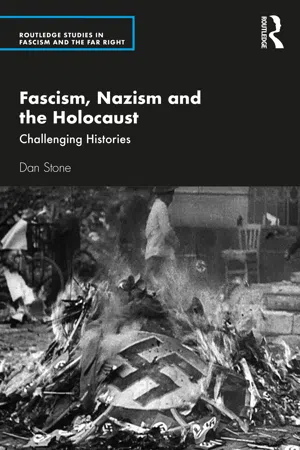History
Concentration Camps
Written by Perlego with AI-assistance
Related key terms
3 Key excerpts on "Concentration Camps"
- eBook - ePub
Enacting History
A Practical Guide to Teaching the Holocaust through Theater
- Mira Hirsch, Janet E. Rubin, Arnold Mittelman(Authors)
- 2020(Publication Date)
- Routledge(Publisher)
Chapter 4 Concentration and extermination camps Context Concentration and extermination camps were a cornerstone of the Nazis’ attempt to rid the Reich of perceived enemies and inferiors. A concentration camp is defined as “a camp in which people are detained or confined, usually under harsh conditions and without regard to legal norms of arrest and imprisonment that are acceptable in a constitutional democracy” (“Concentration Camps, 1933–39”). What many may not realize, however, is that the term does not define all the types of camps and internment locations established by the Nazis. The purposes of these facilities varied, as did the length of time that they were in existence. The number of camps and ghettos established from 1933 to 1945 exceeded 42,000. People were deported to the camps because of race, religion, nationality or politics. Imprisoned were intellectuals, political prisoners, criminals, Social Democrats, Communists, Roma (Gypsies), Jehovah’s Witnesses, those the Nazis considered social misfits or inferiors, such as gays, beggars, tramps and alcoholics, and of course, Jews. The camps were run by the SS, led by Heinrich Himmler, and were differentiated by function. Similar to a prison, the Nazis saw camps as a way to separate certain groups seen as undesirable by the rest of society. Unlike a prison, those confined had not been convicted of crimes nor given a release date. For millions, the only way out was death. Lagersystem was the term used for the system of camps created by the Nazis. These included camps for forced laborers and prisoners of war as well as transit camps, Concentration Camps and sub-camps, and death camps. Some had explicit reasons for being; others served multiple purposes. Labor camps, for example, were used as places where prisoners worked within the camp or in factories or stone quarries, on farms, or wherever else they might be needed - eBook - ePub
Fascism, Nazism and the Holocaust
Challenging Histories
- Dan Stone(Author)
- 2020(Publication Date)
- Routledge(Publisher)
3 If all of these sites are Concentration Camps, then we rapidly come to the conclusion that there is no archetypal camp, that a camp need not look like Dachau in order to qualify as a concentration camp, and that the concept of the concentration camp needs to be historicized, for what it designates changes over time.Histories
Concentration Camps did not appear out of nowhere. There is a long history of incarceration that includes workshops, POW camps, asylums, quarantine islands, slavery plantations and prisons. The idea of isolating unwanted population groups precedes the modern age. The most important precedent is to be found in the European overseas colonies, ‘spaces of exception from European law’, places in which, as Hannah Arendt argued, anything was possible.4 The consistent forced relocation of American Indians, the forcing off the land of Aborigines in Australia and the wiping out of whole populations such as San Bushmen or Caribs were all justified on the grounds that the ‘natives’ were not able to follow the laws of civilized warfare. Specific cases such as Flinders Island off the coast of Tasmania or Shark Island off the Namibian coast are very close approximations of Concentration Camps, except that they were ‘ready-made’ rather than constructed. Indeed, the first wave of camps to be known as ‘Concentration Camps’ were located in the European colonies: Cuba, South Africa, the Philippines, German Southwest Africa. In the first three of these places, Concentration Camps were established primarily as a military solution to guerrilla warfare. By removing the displaced rural population, guerrilla fighters would lose their source of food, shelter and morale, and the civilian authorities could engage in social engineering. German Southwest Africa is somewhat different; here the camps were established after the war, more as a means of pacifying and humiliating a defeated enemy and forcing them into slave labour than a counter-guerrilla strategy. Revealingly, though, given that the term Konzentrationslager had been used in German, up to that point, to refer to the British camps in South Africa, it is clear that the British experience in their guerrilla war was regarded as some kind of guide by the Germans.5 - eBook - ePub
- Michal Aharony(Author)
- 2015(Publication Date)
- Routledge(Publisher)
Lastly, according to the Nazi “idealism,” the Concentration Camps were used “for large-scale scientific experimentation, supposedly for the benefit of mankind.” 55 Kogon emphasizes the fact that the Concentration Camps kept increasing in number even after the Nazis repressed all opposition and before the outbreak of the Second World War. In fact, as time went by, the subsidiary purposes of the camps—deterring the population, exploiting slave labor, and maintaining the training and experimental facilities for the SS—came more and more to the fore. By the time the war erupted, the concentration camp system had grown to horrifying proportions. 56 The inmates of the Concentration Camps belonged to four main groups in the eyes of the Gestapo: political opponents; members of “inferior races”; criminals; and “shiftless elements” (called “asocial” by the Germans). Prisoners of all categories had to wear prescribed marking sewn to their clothing—a serial number and a color-coded triangle badge (Winkel). The majority of the prisoners of the first group—political prisoners (red triangle)—consisted of members of anti-Nazi parties: Communists, Social Democrats, trade unionists, liberals, Freemasons, and anarchists. 57 However, it also included former Nazi party members accused of different offenses. Opposition to the Nazi regime for moral and especially religious motives (for example, Jehovah’s Witnesses, who wore the purple triangle) was regarded by the SS as political opposition. The non-Germans who arrived at the Concentration Camps after the outbreak of the war were almost always classified as political prisoners
Learn about this page
Index pages curate the most relevant extracts from our library of academic textbooks. They’ve been created using an in-house natural language model (NLM), each adding context and meaning to key research topics.


